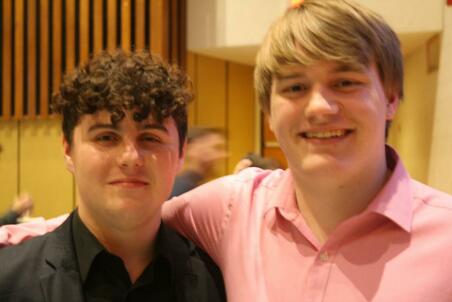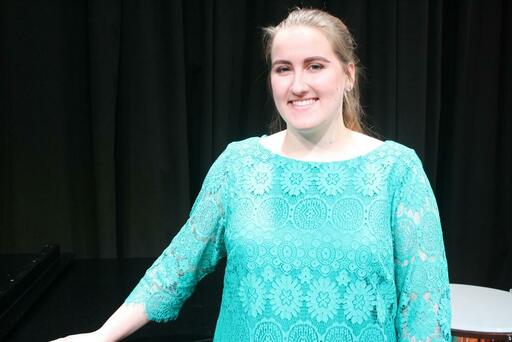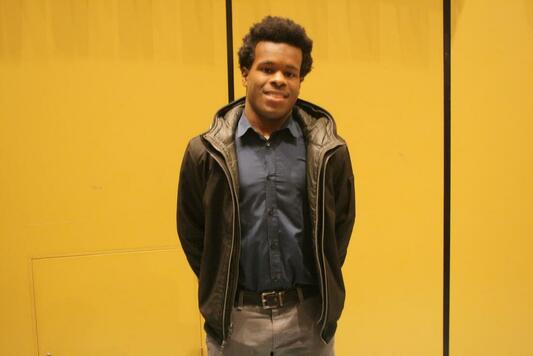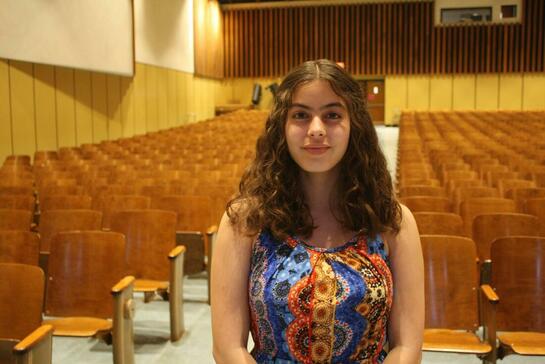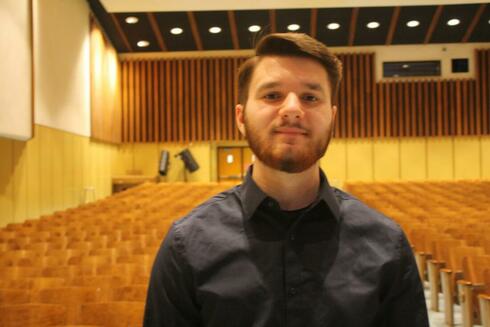IB Senior Music Recitals
Written by Diego de Haan
On Saturday, April 23rd, at Reagan, the seniors of IB Music demonstrated their musical abilities in a recital for the public. IB Music is a course at Reagan offered by IB for musically talented students. The immense talent and intense practice were eminent from all of the performers.
Each performer played solos for about 25 minutes, and the recital was broken down into four individual performances. Each performance consisted of either two or three seniors, making each recital anywhere from an hour to an hour and a half. They all played a wide variety of music on a wide variety of musical mediums. Many pieces were accompanied by pianist Amanda Draheim, which made the performers’ pieces far more polished. After each recital, a reception was held to honor the student’s musical accomplishes; food was served and the performers were praised.
Each performer played solos for about 25 minutes, and the recital was broken down into four individual performances. Each performance consisted of either two or three seniors, making each recital anywhere from an hour to an hour and a half. They all played a wide variety of music on a wide variety of musical mediums. Many pieces were accompanied by pianist Amanda Draheim, which made the performers’ pieces far more polished. After each recital, a reception was held to honor the student’s musical accomplishes; food was served and the performers were praised.
The recital first featured tenor Elijah Wall and percussionist Jack Eisenmann.
|
Jack Eisenmann playing The Entertainer on the xylophon
|
Wall demonstrated his musical ability well and his masterful vocal control was admirable. His choice of pieces showed his capabilities to perform diverse genres of music.
|
Elijah Wall singing Ave Verum Corpus in Latin
|
The second recital featured soprano Lauren Barta, Eliza Borysenko playing the violin, and Aaron Wells with the french horn.
|
Lauren Barta’s performance of For You There is No Song
|
Barta’s performance was entertaining and engaging. Many pieces featured on the recital showed Barta’s ability to perform and keep the audience hooked.
|
Erika Borysenko playing Salut D'amour on violin
|
Borysenko’s skill on the violin was nothing short of masterful, she demonstrated her excellent musical technique and ability.
|
Aaron Wells’ performance of Renaissance Festival on the french horn
|
Well’s ability to execute complicated pieces with perfection is exemplary. His comfort with the french horn was prominent as he demonstrated masterful control of breath, sound, and volume.
Percussionist Preston Carr, soprano Amanda Roman, and mezzo-soprano Samantha Ryan all played in the third performance.
Percussionist Preston Carr, soprano Amanda Roman, and mezzo-soprano Samantha Ryan all played in the third performance.
|
Preston Carr’s of Funky Fat on the Snare Drum
|
Carr’s flexibility and familiarity with various instruments made his performance engaging and compulsive.
|
Amana Roman’s performance of Beau Soir
|
Roman’s vocal talent and range are impressive and her performance was a beautiful exhibition of her skill.
|
Samantha Ryan playing Danza Danza
|
Ryan’s vocal control was eminent in her portion of the recital. Her techniques were equally as prominent.
The fourth and final performance featured tenor Deacon Leer, who also played piano, and Casimir Riley on the baritone saxophone.
The fourth and final performance featured tenor Deacon Leer, who also played piano, and Casimir Riley on the baritone saxophone.
|
Deacon Leer’s performance of Piano Man
|
Leer’s captivating performance had the audience engaged every second. His abilities, with his voice and the piano, were striking.
|
Casimir Riley playing Sicilienne on the baritone saxophone
|
Riley’s skill with the saxophone is evidence of immense practice and dedication. His application of complex and difficult musical techniques is outstanding.
Overall, each student who performed at the IB Music recital has superb musical abilities. Their knowledge of music is evident in their remarkable performance. The musical journey IB Music has taken them on has aided in their future as musicians.
In an interview with Erica Breitbarth, Music Department Chair at Reagan, Breitbarth broke down what exactly IB Music is, and the senior recital. She explains IB Music as, “a class for students who want to do advanced level music learning.” The students learn everything from “music theory, music history, and solo performance.” The class is offered by IB and is a one year course for Standard Level (SL) and a two year course for Higher Level (HL). Breitbarth explains that “most of what we do in ensembles are preparing students to be in IB Music.” Though participating in band, choir, or orchestra is not a requirement of IB Music, it is to help prepare for the class.
To join IB Music, as put by Breitbarth, students must demonstrate that “they have a high level of performance.” During sophomore advising, students can fill out an interest form and take a mini music theory test just to see that students have an understanding of music knowledge needed for IB Music. Breitbarth states, “if you’re doing well in your freshmen and sophomore ensembles and you’ve taken some opportunities to perform outside of class, then you’re well qualified to be in the course.”
In terms of what IB Music entails, in the first year of IB Music HL students learn about music history and composition and musical analysis. The following year, IB music for HL students is an independent study where students write three original musical compositions, take a written exam on musical analysis, and prepare for the IB Music senior recital. The senior recital is graded based on the IB performance rubric. Breitbarth explains, “they are graded on the selection of repertoire, so the pieces they chose, technique, musical communication, and on their understanding of style.”
Breitbarth explains how the 2019 IB Music recital went: “The students performed at a really high level. They were very well prepared this year. It was well attended by both friends and family.” All the seniors did a fantastic job and well demonstrated their abilities and capabilities with music. Their performances at the recital are indicative a future full of more musical opportunities.
Overall, each student who performed at the IB Music recital has superb musical abilities. Their knowledge of music is evident in their remarkable performance. The musical journey IB Music has taken them on has aided in their future as musicians.
In an interview with Erica Breitbarth, Music Department Chair at Reagan, Breitbarth broke down what exactly IB Music is, and the senior recital. She explains IB Music as, “a class for students who want to do advanced level music learning.” The students learn everything from “music theory, music history, and solo performance.” The class is offered by IB and is a one year course for Standard Level (SL) and a two year course for Higher Level (HL). Breitbarth explains that “most of what we do in ensembles are preparing students to be in IB Music.” Though participating in band, choir, or orchestra is not a requirement of IB Music, it is to help prepare for the class.
To join IB Music, as put by Breitbarth, students must demonstrate that “they have a high level of performance.” During sophomore advising, students can fill out an interest form and take a mini music theory test just to see that students have an understanding of music knowledge needed for IB Music. Breitbarth states, “if you’re doing well in your freshmen and sophomore ensembles and you’ve taken some opportunities to perform outside of class, then you’re well qualified to be in the course.”
In terms of what IB Music entails, in the first year of IB Music HL students learn about music history and composition and musical analysis. The following year, IB music for HL students is an independent study where students write three original musical compositions, take a written exam on musical analysis, and prepare for the IB Music senior recital. The senior recital is graded based on the IB performance rubric. Breitbarth explains, “they are graded on the selection of repertoire, so the pieces they chose, technique, musical communication, and on their understanding of style.”
Breitbarth explains how the 2019 IB Music recital went: “The students performed at a really high level. They were very well prepared this year. It was well attended by both friends and family.” All the seniors did a fantastic job and well demonstrated their abilities and capabilities with music. Their performances at the recital are indicative a future full of more musical opportunities.
Changing the View of the Typical Thriller
Jordan Peele’s Us and How It Is Setting the Bar For Upcoming Filmmakers
Written by Jay Chontal
One of the most relevant names in the film industry when it comes to the thriller genre is none other than Jordan Peele. Peele is previously known for his comedic presence on Comedy Central through the famous television show, Key and Peele starring Keegan-Michael Key and Jordan Peele himself. Though Peele’s prolific relevance has pertained to his comedy career, in the most recent years he has branched out into the line of filming, and most recently with a national release of the film Us.
With a film as ambitious and anticipated as Us, Peele was successful in delivering a spectacular film with many different aspects that engaged the viewers through every corner of the film. From the plot, to the overall framing, and even the use of Peele’s natural sense of humor, Peele was able to display his cinematic talent without washing up a generalized horror film that consists of jumpscare after jumpscare.
As director of Us, Peele had almost all artistic control of the film. Different from other industry films, he wrote, directed, and edited all of the film from start to finish. Within the film industry, a lot of artistic freedom is hard to come by, which is why Peele was fortunate to have creative ability at his disposal.
Plot structure throughout the entirety of the film was well written, as Peele enlightens the audience with a fresh take on duality through the experiences of the Wilson family as they take a vacation to the lakefront home that Adelaide Wilson grew up in. With a husband and two children at her side, they take a visit to the same beach where Adelaide encountered an evil version of herself in a house of mirrors. Shortly after the beach day, the Wilsons encountered their counterparts and eventual enemies.
Interestingly enough, Peele decides to keep every one of the family members alive, but with that went a game of chase. Each family member of the original family was forced to run for their lives as their evil selves were close behind ready to finally kill them. Under this creative decision, Peele strays away from the typical slasher film, and drives his film in a direction that is new. Freshness was the key to this film.
In addition to the direction the film was headed, the film was overall less of a horror than it was a psychological thriller. While Peele incorporated many instances that correlate to the horror genre, the parts that grabbed the audience's’ attention were those that were built on the simple concept of suspense. While horror can create suspense, the typical horror genre film is built with the idea of grotesque violence and jumpscares, which is sets this film apart from many others. Decisively, Peele was able to create an atmosphere that audiences will not forget when walking out of the theatre, with a slight edge of gruesome killings.
While Peele was able to deliver an amazing plot, it is nothing without the stylistic choices that Peele chose to incorporate throughout the film, most noticeably the excellent framing, better known as the cinematography choices. The main goal of a film in the scary/thriller genre is to build suspense with the use of intricate framing. Peele accomplishes this task very well and does not leave the audience with a cheap jumpscare. For this reason, Us is set apart from many other horror films, as they mostly rely on the use of a quick cut to surprise the audience with a killing. Although divergent from others, Peele ensures his tactics work.
Throughout the film, Peele utilized a variety of shot types, without creating a stale environment. With variety comes a lot of responsibility; knowing when to emphasize a character or when to create distance. In addition, Peele does a great job of making sure everything within a scene makes sense. In this manner, continuity was well preserved. Editing was also well crafted so that the audience did not lose track of what was happening within a specific scene.
Within the film, Peele does a great job of establishing a scene, and proceeding on with that. Many scenes will start with an establishing shot, such as the scene where the Wilson’s corrupt other halves take complete control of the house. An establishing shot emphasized the order that was created by the corrupted versions inside of the living room. Slowly, over the course of a simple conversation, Peele starts to move in closer to each character, and through that, building suspense.
Aesthetically, Peele tackles the idea of duality further through the way he works with shadows all throughout the film. During times of darker and scarier situations, Peele utilizes shadows to further create tension. Most importantly, the use of shadows compliments many of the scenes in which evil versions of the family are present.
With a film as ambitious and anticipated as Us, Peele was successful in delivering a spectacular film with many different aspects that engaged the viewers through every corner of the film. From the plot, to the overall framing, and even the use of Peele’s natural sense of humor, Peele was able to display his cinematic talent without washing up a generalized horror film that consists of jumpscare after jumpscare.
As director of Us, Peele had almost all artistic control of the film. Different from other industry films, he wrote, directed, and edited all of the film from start to finish. Within the film industry, a lot of artistic freedom is hard to come by, which is why Peele was fortunate to have creative ability at his disposal.
Plot structure throughout the entirety of the film was well written, as Peele enlightens the audience with a fresh take on duality through the experiences of the Wilson family as they take a vacation to the lakefront home that Adelaide Wilson grew up in. With a husband and two children at her side, they take a visit to the same beach where Adelaide encountered an evil version of herself in a house of mirrors. Shortly after the beach day, the Wilsons encountered their counterparts and eventual enemies.
Interestingly enough, Peele decides to keep every one of the family members alive, but with that went a game of chase. Each family member of the original family was forced to run for their lives as their evil selves were close behind ready to finally kill them. Under this creative decision, Peele strays away from the typical slasher film, and drives his film in a direction that is new. Freshness was the key to this film.
In addition to the direction the film was headed, the film was overall less of a horror than it was a psychological thriller. While Peele incorporated many instances that correlate to the horror genre, the parts that grabbed the audience's’ attention were those that were built on the simple concept of suspense. While horror can create suspense, the typical horror genre film is built with the idea of grotesque violence and jumpscares, which is sets this film apart from many others. Decisively, Peele was able to create an atmosphere that audiences will not forget when walking out of the theatre, with a slight edge of gruesome killings.
While Peele was able to deliver an amazing plot, it is nothing without the stylistic choices that Peele chose to incorporate throughout the film, most noticeably the excellent framing, better known as the cinematography choices. The main goal of a film in the scary/thriller genre is to build suspense with the use of intricate framing. Peele accomplishes this task very well and does not leave the audience with a cheap jumpscare. For this reason, Us is set apart from many other horror films, as they mostly rely on the use of a quick cut to surprise the audience with a killing. Although divergent from others, Peele ensures his tactics work.
Throughout the film, Peele utilized a variety of shot types, without creating a stale environment. With variety comes a lot of responsibility; knowing when to emphasize a character or when to create distance. In addition, Peele does a great job of making sure everything within a scene makes sense. In this manner, continuity was well preserved. Editing was also well crafted so that the audience did not lose track of what was happening within a specific scene.
Within the film, Peele does a great job of establishing a scene, and proceeding on with that. Many scenes will start with an establishing shot, such as the scene where the Wilson’s corrupt other halves take complete control of the house. An establishing shot emphasized the order that was created by the corrupted versions inside of the living room. Slowly, over the course of a simple conversation, Peele starts to move in closer to each character, and through that, building suspense.
Aesthetically, Peele tackles the idea of duality further through the way he works with shadows all throughout the film. During times of darker and scarier situations, Peele utilizes shadows to further create tension. Most importantly, the use of shadows compliments many of the scenes in which evil versions of the family are present.
Leaving The Snow, Enter The Bloom
Written By: Abdullah Al-Bassam
White sheets
And naked branches
Here to hibernate
Here to leave
Colorful flora
Plan to stay
Unpredictable weather
Ready to play
Staying so frosty
And quite so wintry
But enough to see
The ending
Hues bloom
Right and left
Enough to tell
A vibrant beginning
Leaving the shades
Entering the colors
Removing the plain
While adding the content
Spring is here.
Here to stay.
And naked branches
Here to hibernate
Here to leave
Colorful flora
Plan to stay
Unpredictable weather
Ready to play
Staying so frosty
And quite so wintry
But enough to see
The ending
Hues bloom
Right and left
Enough to tell
A vibrant beginning
Leaving the shades
Entering the colors
Removing the plain
While adding the content
Spring is here.
Here to stay.
